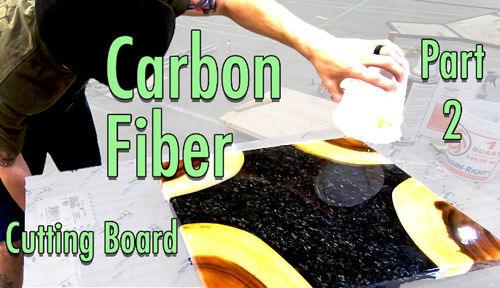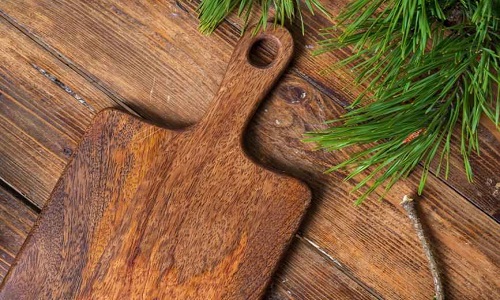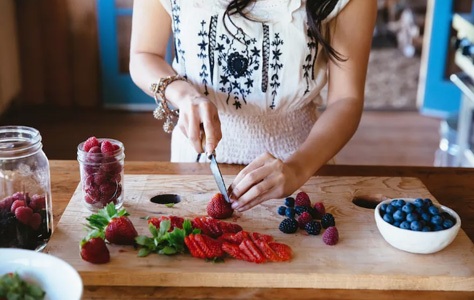How To Treat Bamboo Cutting Board?10 Easy Step
A bamboo cutting board is not only an essential tool for every kitchen but also a sustainable and eco-friendly alternative to traditional wooden boards. Renowned for its natural strength, resilience, and antimicrobial properties, bamboo has become a popular choice among home cooks and professional chefs alike. However, to ensure its longevity and maintain its hygienic properties, proper treatment and care are paramount.
In this comprehensive guide, we will walk you through the essential steps on how to treat your bamboo cutting board. From initial preparation and regular cleaning to the application of protective oils, you will discover the key practices to keep your cutting board in pristine condition. By following these steps, you can extend the lifespan of your bamboo cutting board and relish in a clean, safe, and attractive surface for all your culinary adventures.
How To Treat Bamboo Cutting Board Step By Step Process
Treating a bamboo cutting board is essential to maintain its longevity, hygiene, and appearance. Follow these steps to properly treat your bamboo cutting board:
- Wash Before First Use: Before using the bamboo cutting board for the first time, wash it with warm soapy water and rinse thoroughly. This will remove any dust or residue from the manufacturing process.
- Regular Cleaning: After each use, clean the cutting board with warm soapy water and a gentle scrub brush. Avoid using harsh cleaning agents, as they may damage the bamboo or strip away its natural oils.
- Sanitize with Vinegar: To disinfect the cutting board, periodically sanitize it with white vinegar. Simply apply vinegar to the surface, let it sit for a few minutes, then rinse thoroughly with water.
- Avoid Soaking: Never soak the bamboo cutting board in water or let it sit in a sink filled with water. Excessive exposure to water can cause the bamboo to absorb moisture and potentially lead to warping or cracking.
- Dry Properly: After washing, pat the cutting board dry with a clean towel, and then allow it to air dry completely in an upright position. Avoid leaving it flat on a wet surface, as this could trap moisture and encourage mold growth.
- Oil Treatment: Periodically (approximately once a month or as needed), apply a food-grade mineral oil or specifically designed bamboo oil to the cutting board. The oil will help moisturize the bamboo, prevent it from drying out, and protect it from water absorption.
- Oil Application: To apply the oil, use a clean, soft cloth or a paper towel. Apply a generous amount of oil to the surface of the cutting board, spreading it evenly over the entire surface, including the edges. Let the oil soak in for a few hours or overnight if possible.
- Wipe Off Excess: After the oil has had time to penetrate the bamboo, wipe off any excess oil with a dry cloth. This step ensures that the cutting board won’t feel greasy when you use it again.
- Store Properly: Store the bamboo cutting board in a dry and well-ventilated area. Avoid storing it in a damp or dark place, as this can promote mold growth.
- Reseal if Necessary: Over time, the bamboo cutting board may show signs of wear, such as dryness or roughness. If this happens, you can reapply the food-grade mineral oil or bamboo oil to restore its appearance and condition.
By following these steps, you can keep your bamboo cutting board in excellent shape, allowing you to enjoy safe and hygienic food preparation for years to come. Properly treating and maintaining your cutting board will also help retain its natural beauty and durability.
How to Condition Your Bamboo Cutting Board?
Conditioning your bamboo cutting board is a crucial step in maintaining its appearance, strength, and longevity. Conditioning involves applying a protective coating, typically using food-grade mineral oil or bamboo-specific oil, to keep the bamboo moisturized and shielded from moisture and other potential damage. Here’s a step-by-step guide on how to condition your bamboo cutting board:
- Clean the Cutting Board: Start by washing the bamboo cutting board with warm soapy water and a soft sponge or scrub brush. Rinse it thoroughly to remove any food particles or residue.
- Allow Drying Time: After washing, pat the cutting board dry with a clean towel. Let it air dry completely in an upright position to ensure that all moisture evaporates.
- Select the Oil: Choose a food-grade mineral oil or a bamboo-specific oil for conditioning. Avoid using cooking oils like vegetable or olive oil, as they can turn rancid and leave a sticky residue.
- Apply the Oil: Using a clean, soft cloth or a paper towel, apply a generous amount of oil to the entire surface of the bamboo cutting board, including the edges. Ensure even coverage, so no part of the board is left untreated.
- Let the Oil Soak In: Allow the oil to penetrate the bamboo for a few hours or even overnight, if possible. This will help the bamboo absorb the oil, restoring its natural moisture and preventing it from becoming dry and prone to cracks.
- Wipe Off Excess: After the oil has had sufficient time to soak in, use a dry cloth to wipe off any excess oil. This step is essential to prevent the cutting board from feeling greasy during use.
- Repeat as Needed: Depending on how frequently you use the cutting board, reapply the oil approximately once a month or as needed. Regular conditioning will help maintain the bamboo’s strength and appearance.
- Store Properly: When not in use, store the bamboo cutting board in a dry and well-ventilated area. Avoid placing it in direct sunlight or near a heat source, as extreme temperatures can lead to warping.
By regularly conditioning your bamboo cutting board, you can keep it looking new, prevent drying and cracking, and create a hygienic surface for all your food preparation needs. Additionally, conditioning will help prolong the life of your bamboo cutting board, making it a reliable and sustainable kitchen companion for years to come.
How to treat the bamboo cutting board with olive oil
If you’re looking for a natural way to treat your bamboo cutting board, olive oil is a great option. Here’s how to do it:
1. Pour a small amount of olive oil onto a clean cloth.
2. Rub the oil into the surface of the cutting board, using circular motions.
3. Allow the oil to soak in for a few minutes, then buff it off with a clean, dry cloth.
4. Repeat this process as needed to keep your cutting board in good condition.
Oil for bamboo cutting board
Bamboo cutting boards are a great option for those looking for an eco-friendly and durable cutting board. Bamboo is a sustainable material that is also very strong, making it ideal for a cutting board. However, bamboo cutting boards require a little bit of care to keep them looking their best.
One important thing to keep in mind when caring for your bamboo cutting board is that you should never use oil on it. Oil will eventually go rancid and can transfer flavors to your food. Instead, you should use a food-safe mineral oil to keep your bamboo cutting board in good condition.
To clean your bamboo cutting board, simply wash it with warm water and soap. You can also use a mild bleach solution to disinfect it, if desired. Allow the board to air dry completely before using it again.
With proper care, your bamboo cutting board can last for many years. Enjoy using it for all your food prep needs!
How to treat the bamboo cutting board with mineral oil
Bamboo is an environmentally friendly material that makes for great cutting boards. However, bamboo is a porous material, which means it can absorb water and other liquids. This can lead to warping and cracking over time.
To help prevent this, it’s important to treat your bamboo cutting board with mineral oil. Mineral oil is a food-safe option that will help to seal the pores of the bamboo and protect it from water damage. Here’s how to treat your bamboo cutting board with mineral oil:
1. Start by thoroughly cleaning your bamboo cutting board. Use warm water and mild soap. Be sure to rinse it well.
2. Next, pour a small amount of mineral oil onto a clean cloth.
3. Rub the oil into the surface of the bamboo cutting board, using circular motions.
4. Allow the board to dry for a few minutes, then apply a second coat of oil.
5. Wipe away any excess oil with a clean cloth.
6. Your bamboo cutting board is now ready for use! Be sure to apply a new coat of oil every few months, or as needed.
How to season bamboo cutting board
If you’re looking for a cutting board that’s eco-friendly and stylish, bamboo is a great option. But before you can start using your bamboo cutting board, you need to season it. Here’s how to do it:
1. Start by rubbing the board down with a little vegetable oil. This will help to protect the bamboo and prevent it from drying out.
2. Next, use a clean cloth to apply a thin layer of beeswax.
This will further protect the board and make it more durable.
3. Finally, buff the board with a soft cloth to make it shine. Now your bamboo cutting board is ready to use!
Be sure to take care of it by regularly oiling and waxing it. With proper care, it will last for years to come.
Treating bamboo cutting board with coconut oil
Bamboo cutting boards are a popular choice for many home cooks because they are eco-friendly and durable. Bamboo is also a very porous material, which means that it can absorb flavor and color from your food. That’s why it’s important to treat your bamboo cutting board with coconut oil before using it.
Coconut oil is a natural antibacterial and antifungal agent, so it will help to keep your cutting board clean. It also helps to protect the board from moisture and staining. To treat your bamboo cutting board, simply rub a generous amount of coconut oil into the surface of the board with a clean cloth.
Be sure to get into all of the nooks and crannies. Let the board sit for at least an hour so that the oil can fully soak in. After treating your bamboo cutting board with coconut oil, it will be ready to use.
Be sure to wash it with hot, soapy water after each use and dry it thoroughly to keep it in good condition. With proper care, your bamboo cutting board can last for many years.
How to clean bamboo cutting board
Bamboo cutting boards are a great alternative to traditional wooden cutting boards. They are durable, easy to clean, and won’t dull your knives. Here’s how to clean your bamboo cutting board:
1. Rinse the board with warm water and soap. Use a mild dish soap to avoid damaging the bamboo.
2. Scrub the board with a soft bristle brush.
This will help remove any stuck-on food.
3. Rinse the board again with warm water.
4. Dry the board with a clean towel.
5. Apply a food-safe mineral oil to the board. This will help protect the bamboo from water damage and keep it looking its best. Follow these simple steps and your bamboo cutting board will stay clean and looking great for years to come!
How long does a bamboo cutting board Last
Bamboo is one of the most popular materials for cutting boards and for good reason. Bamboo is strong and durable, yet gentle on knives. It’s also eco-friendly and renewable.
But how long does a bamboo cutting board last? With proper care, a bamboo cutting board can last for years. Here are a few tips for prolonging the life of your bamboo cutting board:
- Wash it by hand with warm, soapy water after each use.
- Avoid putting it in the dishwasher, as this can cause the bamboo to warp.
- Do not allow it to soak in water for long periods of time.
- Do not cut on the board with very sharp knives.
- Periodically oil the board with a food-safe oil to keep it from drying out.
By following these simple tips, you can enjoy your bamboo cutting board for many years to come.
How do you seal a bamboo cutting board?
Bamboo is a beautiful, sustainable material that makes for great cutting boards. But like any cutting board, bamboo can suffer from wear and tear. Over time, the surface of your bamboo cutting board can become stained and scratched.
To keep your board looking its best, it’s important to seal it periodically.
Sealing a bamboo cutting board is a simple process. Just choose a food-safe sealer and apply it to the board with a clean cloth.
Be sure to seal the board on both sides and allow it to dry completely before using it. With proper care, your bamboo cutting board will last for years.
What oil do you use on a bamboo cutting board?
Bamboo cutting boards are a great alternative to traditional wooden cutting boards. They are durable, easy to clean, and cost-effective. When it comes to oiling a bamboo cutting board, there are a few things to keep in mind.
First, it’s important to choose an oil that is food-safe. Mineral oil is a popular option, but you can also use coconut oil or olive oil. Avoid using any oils that are not food-safe, as they can potentially transfer toxins to your food.
Second, apply the oil to your cutting board using a clean, dry cloth. Rub it in well, making sure to cover the entire surface of the board.
Third, allow the oil to soak into the board for at least an hour before using it.
This will help to keep your board in good condition and prevent it from drying out.
Finally, remember to oil your bamboo cutting board regularly. This will help to keep it looking its best and prevent it from becoming damaged.
By following these simple tips, you can keep your bamboo cutting board in good condition for years to come.
Can I treat my bamboo cutting board with olive oil?
Yes, you can treat your bamboo cutting board with olive oil. This will help to protect the board from water damage and keep it looking new. To do this, simply rub a small amount of oil into the board with a clean cloth.
Let the board dry for a few hours before using it.
How do you care for a natural bamboo cutting board?
Assuming you’re talking about a cutting board made from bamboo: Bamboo is grass that is part of the Poaceae family. It grows in many different climates but is most commonly found in Asia.
Bamboo is a sustainable resource because it grows quickly and does not require chemicals or much water to thrive. When choosing a bamboo cutting board, look for one that is made of solid bamboo and is free of any chemicals or finishes. Bamboo cutting boards can be cared for like any other cutting board.
Wash it with warm, soapy water after each use. You can also sanitize it with vinegar and water solution. To help prevent bamboo cutting boards from cracking or splintering, avoid putting them in the dishwasher or soaking them in water.
If your bamboo cutting board does crack or splinter, sand it down with fine-grit sandpaper and apply mineral oil to help seal and protect the board.
Conclusion
Bamboo is a sustainable material that makes for a great cutting board. It is important to treat your bamboo cutting board with care to ensure that it lasts a long time. Here are some tips on how to treat your bamboo cutting board:



![How to Clean Wooden Cutting Board Mold [Expert Tips]](https://kitchenapplince.com/wp-content/uploads/2022/08/How-to-Clean-Wooden-Cutting-Board-Mold.jpg)
